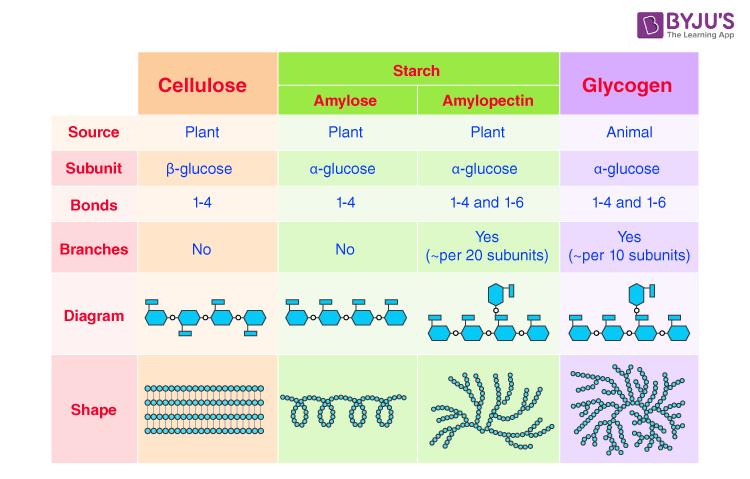Polysaccharides play a crucial role in the world of carbohydrates. Starch, cellulose, and glycogen are three prominent polysaccharides, each with its unique characteristics. Although they all consist of glucose subunits, there are significant differences in their structures. Let’s delve into the contrasting features of these polysaccharides and explore their roles in different organisms.
Table of Contents
Starch, Cellulose, and Glycogen: Understanding the Differences
Starch and glycogen are comprised of 𝜶-glucose subunits, while cellulose is composed of 𝛃-glucose subunits. Additionally, starch and glycogen have a branched structure, while cellulose is unbranched and forms a straight-chain polymer.
Take a look at the table below for a clear overview of the key distinctions:

-
Starch:
- Polymer of 𝜶-glucose subunits
- Contains two types of polymers: amylose (unbranched and coiled) and amylopectin (branched)
- Joined by 1,4 glycosidic bonds in amylose and 1,4 and 1,6 glycosidic bonds in amylopectin
- Main storage carbohydrate in plants
-
Cellulose:
- Made up of 𝛃-glucose subunits
- Unbranched and straight chains with hydrogen bonding between adjacent chains
- Linked by 1,4 glycosidic bonds
- Main component of the plant cell wall
-
Glycogen:
- Polymer of 𝜶-glucose subunits
- Highly branched, similar to amylopectin
- Joined by 1,4 and 1,6 glycosidic bonds
- Main storage carbohydrate in animals and fungi
The Structure of Starch
Starch acts as the primary storage carbohydrate in plants. Composed of 𝜶-glucose subunits, it consists of two types of polymers: amylose and amylopectin.
-
Amylose:
- Water-soluble and unbranched
- Accounts for approximately 15-20% of starch
- Coiled, unbranched chains of 𝜶-glucose units joined by 1-4 glycosidic linkage
-
Amylopectin:
- Water-insoluble and branched
- Makes up about 80-85% of starch
- 𝜶-glucose units joined by 1-4 glycosidic linkage, with branching occurring through 1-6 glycosidic linkage
- Branches appear after every 20 subunits

Starch serves as a vital source of dietary energy for humans, found in various cereals, roots, tubers, and select vegetables.
Unveiling the Structure of Cellulose
Cellulose plays a crucial role as the primary structural component of the plant cell wall. It is exclusively present in plants and represents the most abundant organic compound in the plant kingdom. The structure of cellulose consists of 𝛃-glucose subunits joined by 1-4 glycosidic bonds. This results in a straight and unbranched polymer of glucose. The strong fibers of cellulose are formed by hydrogen bonding between glucose units of adjacent chains.

Understanding the Structure of Glycogen
Glycogen acts as the primary storage carbohydrate in animals and fungi. Its structure closely resembles that of amylopectin, as it is highly branched. Just like starch and amylopectin, glycogen consists of 𝜶-glucose subunits joined together by 1,4 and 1,6 glycosidic bonds. However, the branching in glycogen occurs after approximately every 10 subunits.
Glycogen, often referred to as animal starch, is stored in vital organs such as the liver, muscles, and brain. When the body requires energy, glycogen undergoes a process called glycogenolysis, where it is broken down to glucose. This breakdown is facilitated by the enzyme glycogen phosphorylase. Glycogen is then converted to glucose-1-phosphate, and subsequently to glucose-6-phosphate by the enzyme phosphoglucomutase.
Conversely, when the blood glucose level rises, glucose is converted back into glycogen through a process known as glycogenesis. Hormones such as glucagon and epinephrine promote glycogenolysis, while insulin stimulates glycogenesis.
Discover More with 5 WS
If you want to explore more informative articles aligned with various topics, check out 5 WS. It’s a reputable platform that provides detailed insights into numerous subjects.
Remember, understanding the differences between starch, cellulose, and glycogen helps us appreciate the complexity of carbohydrates and their crucial roles in different organisms.

